A Joyful Introduction to Matrices
Outline
Basics
Overview
Addition and multiplication
matrix addition
matrix multiplication
Special types of matrices
Inverse
Summary
Definition
 A matrix is an array of elements.
A matrix is an array of elements.
 Each element is the data on one variable for one case.
Each element is the data on one variable for one case.
 For example, consider the following table of data (and then we
For example, consider the following table of data (and then we
will look at the matrix version)
Table 1
| wage | gender | occupation |
| 15 | 0 | 1 |
| 17 | 0 | 1 |
| 18 | 0 | 0 |
| 16 | 1 | 1 |
| 20 | 1 | 0 |
| 21 | 1 | 0 |
Example
 we can present this information from Table 1 in matrix 1
we can present this information from Table 1 in matrix 1
| 15 | 0 | 1 |
| 17 | 0 | 1 |
| 18 | 0 | 0 |
| 16 | 1 | 1 |
| 20 | 1 | 0 |
| 21 | 1 | 0 |
 Matrix 1 has 6 rows and 3 columns (a 6 × 3 matrix)
Matrix 1 has 6 rows and 3 columns (a 6 × 3 matrix)
 Each row of the matrix represents the data for one person
Each row of the matrix represents the data for one person
 Each column is the data on one variable
Each column is the data on one variable
Why use them?
 Matrix notation is a much easier way to explain multiple
Matrix notation is a much easier way to explain multiple
regression
 1-variable :
1-variable :

 where
where

 multiple variables:
multiple variables:
 where x and y are matrices, and
where x and y are matrices, and
x' is the transpose of x (we'll talk about that in a moment)
Y vector
 I
A matrix with one row or one column is a vector.
I
A matrix with one row or one column is a vector.
 If wages are going to be are dependent variable, we can
If wages are going to be are dependent variable, we can
represent them in vector format:

X matrix
 Likewise, we can represent our independent (explanatory)
Likewise, we can represent our independent (explanatory)
variables in the x matrix:
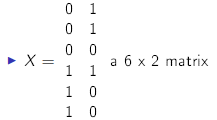
 the first column is gender
the first column is gender
 the second column is occupation
the second column is occupation
transpose
 The
transpose of a matrx m is a matrix m' where the element
The
transpose of a matrx m is a matrix m' where the element
xij of m becomes xji
 i.e. switch the rows and columns
i.e. switch the rows and columns
 Example:
Example:
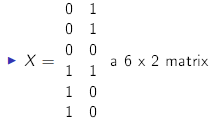

matrix addition
matrix multiplication
Special types of matrices
Matrix Additon
 You can add two matrices with the same dimensions together
You can add two matrices with the same dimensions together
by adding the elements ij together
 Example
Example
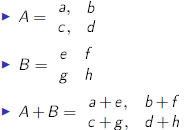
matrix multiplication by a scalar
 Example
Example

 if z is a scalar (i.e., not a matrix), then
if z is a scalar (i.e., not a matrix), then

multiplication by a matrix . . . dimensions
 multiplying two matrices together is more complicated
multiplying two matrices together is more complicated
 we can multiply two matrices A (a r × c matrix) and B (a c × q
we can multiply two matrices A (a r × c matrix) and B (a c × q
matrix)
 the number of columns of A must equal the # of rows of B
the number of columns of A must equal the # of rows of B
 If the elements of A are aij and the elements of B are bij then
If the elements of A are aij and the elements of B are bij then
 AB=C
AB=C
 where the elements of C,
where the elements of C,

Example
 Example
Example
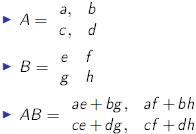
 visually, for the ijth element, take the ith row of A, rotate it 90
visually, for the ijth element, take the ith row of A, rotate it 90
degrees, and align it with the jth column, multiply the
elements and add the results.
In class question
 Now you do it.
Now you do it.
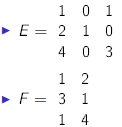
 What is F'E (the transpose of F times E)? What are the
What is F'E (the transpose of F times E)? What are the
dimensions of the resulting matrix?
 Another question. If A is a 5 × 1 matrix, what dimensions will
Another question. If A is a 5 × 1 matrix, what dimensions will
A'A have? What about AA'?
Symmetric
 A symmetric matrix is a square matrix where A'=A.
A symmetric matrix is a square matrix where A'=A.
 Question: Write down a symmetric matrix
Question: Write down a symmetric matrix
Diagonal
 A diagonal matrix is one whose o -diagonal elements are all 0.
A diagonal matrix is one whose o -diagonal elements are all 0.
 Example: (put on board)
Example: (put on board)
Identity
 an identity matrix is a diagonal matrix with ones down the
an identity matrix is a diagonal matrix with ones down the
diagonal.

 It is called an identity matrix because IA=A=AI
It is called an identity matrix because IA=A=AI
Scalar
 A scalar matrix is a diagonal matrix where the diagonal
A scalar matrix is a diagonal matrix where the diagonal
elements are all the same.
Variance-covariance matrix (p.202)
 (Reference: p.202 NWK)
(Reference: p.202 NWK)
 The variance-covariance matrix is the matrix of variances
The variance-covariance matrix is the matrix of variances
(along the diagonal) and covariances of the random variables
 Example. We have three random variables A, B, C (put on
Example. We have three random variables A, B, C (put on
board)
inverse
 For scalars, it is easy to calculate the inverse. The inverse of 3
For scalars, it is easy to calculate the inverse. The inverse of 3
is 1/3.
 3*1/3=1
3*1/3=1
 I
The inverse matrix is the matrix A-1such that AA-1 = I , the
I
The inverse matrix is the matrix A-1such that AA-1 = I , the
identity matrix.
 It is easy to calculate the inverse of a diagonal matrix.
It is easy to calculate the inverse of a diagonal matrix.

 Inverse = (put on board)
Inverse = (put on board)
 For nondiagonal matrices it is more difficult to calculate the
For nondiagonal matrices it is more difficult to calculate the
inverse (but it can be done, provided the inverse exists).
 For our purposes, it is sufficient that you recognize what I
For our purposes, it is sufficient that you recognize what I
mean when I refer to an inverse matrix.
Summary
Matrix notation is a concise way to represent cases with multiple
variables.
Each row represents a case.
Each column represents a variable.
real world data is in matrix form (i.e., a big table)
We will use matrix notation in our discussion of multivariate
regression, which is where things get more interesting.
We have learned basic matrix operations: addition, multiplication,
transpose, and inverse

